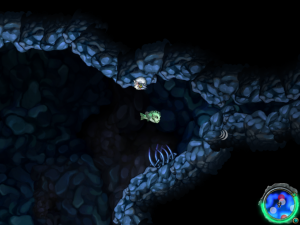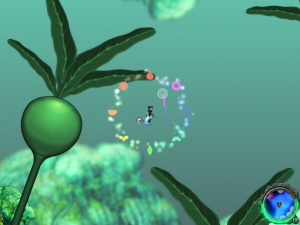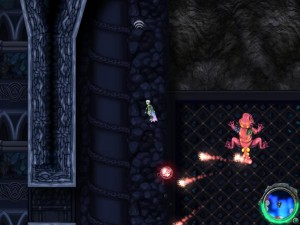Aquaria: Cooking
Aquaria gives the player an inventory of cooking ingredients obtained by killing stuff and/or singing at plants. Collecting ingredients gives the player something to focus on after a fight, pursuing them downward as they plummet out of reach or sometimes following them laterally as they arc ballistically overhead. Different ingredients are plentiful in different areas — it’s easy to obtain crab meat in a cave full of crabs, for example — and there always seems to be some ingredient I’m short on, although which ingredient that is varies.
All cooked foods are basically potions. They either heal you in some way (restoring hit points, curing the few status effects in the game), or they give you temporary bonuses, or both, depending on their ingredients. The most plentiful ingredients are meats and oils, and the most basic things you can prepare are Hot Soup (any oil plus any meat), Sea Cake (any oil plus any egg), Leaf Poultices (leaf plus leaf), and sushi Hand Rolls (leaf plus any meat). More exotic things like pierogies are also feasible, but those four forms are the things that seem to have the greatest number of variations, created by improving them with other items — a basic cake heals you a bit, but a cake plus a leaf yields a Veggie Cake that grants temporary regeneration. It’s notable that the order is significant here: (oil plus meat) plus leaf = Veggie Soup (regeneration), but oil plus (meat plus leaf) = Tasty Roll (healing x2).
The game keeps track of what recipes you’ve discovered, and grants an Achievement for finding them all — something I’m still substantially short of. The nice part is that when you find an item in the wild, you instantly know its recipe. In fact, that’s the chief way that you learn the less intuitive combinations. Some of them are guessable, though, if you think like the game’s creators. Trying to put together an invalid combination yields Sea Loaf, a nigh-useless item that heals a tenth of a hit point. Nonetheless, if you’re going to do experiments, it’s important to max out on Sea Loaf. Your inventory can hold only up to eight of each item, and if you have that many of something, the game doesn’t let you make any more. So if you have eight Sea Loaves already, you can try throwing any random ingredients together, secure in the knowledge that the game won’t waste them on additional Sea Loaf.
My own biggest kitchen triumph was intuiting that turtle soup was a possibility, on the sole basis that I had some turtle meat and no known use for it. I did eventually find the turtle soup recipe the other way, but only after I had used it in several boss fights: turtle soup grants the strongest defensive bonus of any food I’ve seen. Boss fights are pretty much the only place I ever use food. Occasionally I’ll admit to myself that I need to consume a healing item outside of the boss fights, but it always seems like a waste, given the number of other sources of healing in the game. But when facing a boss, I throw on as many buffs as I can, because I know from experience that it makes the difference between victory and defeat.
The thing is, boss fights only happen occasionally, and I probably have enough food on hand already to last me through all the bosses that remain. But I’m still hoarding food, scavenging anything I’m short on, trying to get as close as I can to keeping eight of everything on hand all the time. Not because I need to, but just because it’s one of the activities that the game provides.
 Comments(0)
Comments(0)

